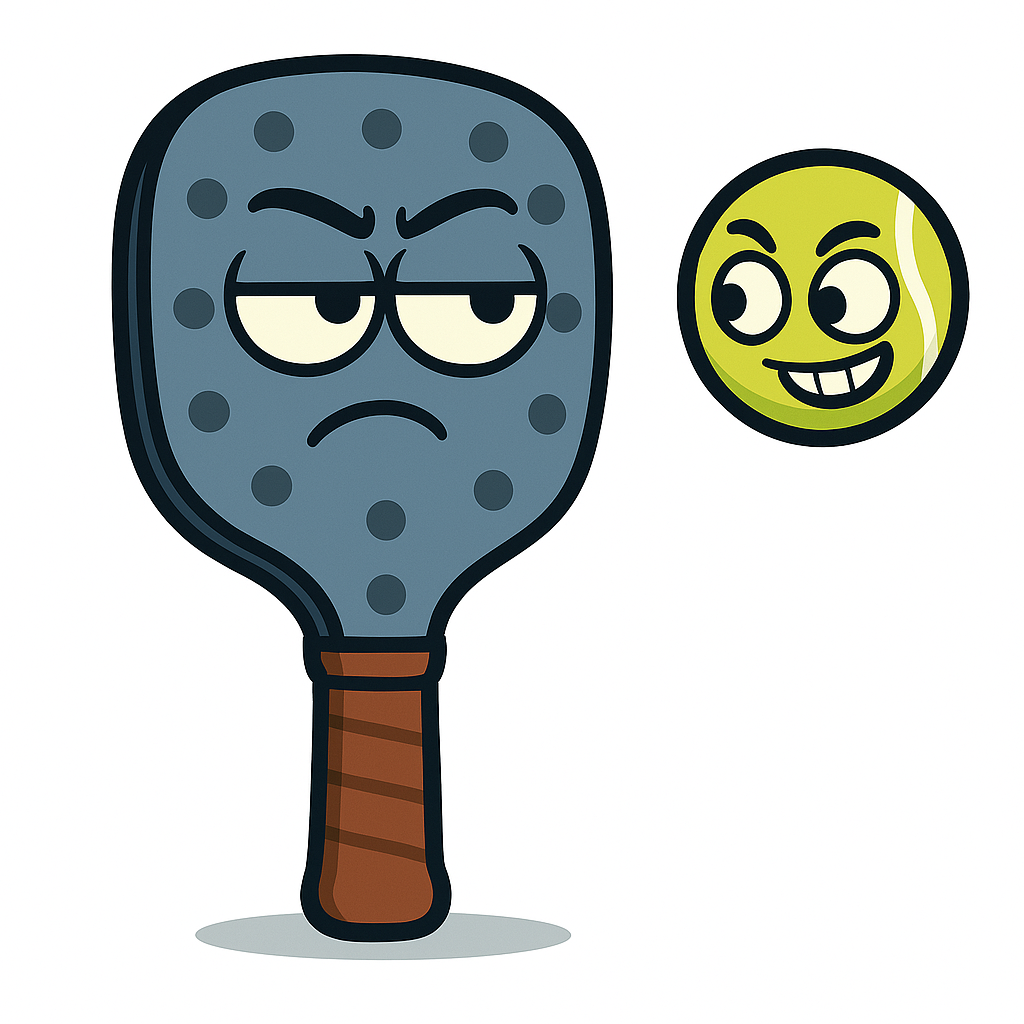Is the United States Tennis Association (USTA) ignoring pickleball? Is it promoting it? Or is it trying to squash it?
If it is trying to squash it, how is it impacting pickleball players, particularly those enjoying public courts?
In 2023, the Seattle Parks and Recreation (SPR) department decided to add pickleball court lines to three of its six Solstice Park tennis courts. Seattle Parks debated for a few weeks which three of the six courts should get pickleball lines. Then, it abruptly decided it would not add pickleball lines to these courts after all. No pickleball lines have been added to existing Seattle public tennis courts ever since.
When I asked Seattle Parks how they came to this decision, Seattle Parks was not forthcoming with an explanation. So, I decided to introduce Public Record Requests to try to figure out how and why this decision reversal took place.
I am sharing my findings with you below.
--Miguel de Campos
TL;DR
The explosive growth of pickleball across America has created a complex battleground over public court space, with the United States Tennis Association (USTA) at the center of a coordinated effort to limit pickleball's expansion. Through internal board meeting minutes, public records requests, and documented policy changes, a troubling pattern emerges of how a powerful sports organization can leverage its institutional influence to shape public recreational policy against a competing sport.
The United States Tennis Association (USTA) executed a systematic campaign from 2023-2024 to prevent pickleball expansion on public courts, successfully influencing public parks departments nationwide to abandon plans for new pickleball facilities. Internal USTA board minutes reveal explicit strategies to "combat pickleball," "protect tennis real estate," and "arm advocates" against the sport they deemed a "critical issue."
In Seattle, this campaign led to the cancellation of planned pickleball lines at Solstice Park, the abandonment of shared court policies, and a complete halt to new public pickleball development despite explosive player growth.
The USTA's "Park Agency Tennis Assessment" program targeted multiple cities with similar results, reportedly "saving" 600 tennis courts from pickleball while public demand for pickleball courts went unmet. This coordinated effort prioritized protecting USTA's interests over equitable allocation of taxpayer-funded recreational facilities.
No Time to Read?
No Problem!
AI to the rescue.
This AI generated podcast will bring you up to speed.
Podcast potential side effects include the desire to read this whole web page.
Acknowledgments
This document did not come together on the wings of inspiration alone. Massive thanks go to those valiant individuals who read early drafts, corrected my comma calamities, questioned my timeline typos, and bravely told me when I sounded like I had swallowed a legal textbook.
To my review team: You are the true defenders of clarity and readability along with grammar and spelling. If there was a Hall of Fame for agreeing to hold pickleball editing above pickleball playing, you’d be in it — likely with matching custom paddles and personalized eye-roll GIFs 🙄. Your dedication transformed this from a humble blog entry into a formidable, source-packed saga of civic pickleball preservation.
Table of Contents
The Sequence of Events Conclusion
What You Can Do
Frequently Asked Questions
The Sequence of Events
11
2022
Seattle Parks Unveils its Latest Pickleball Development Strategy
The strategy has three prongs:
- Immediately add pickleball lines to existing tennis courts
- Convert a few existing underused tennis courts to pickleball in the mid-term
- Construct new dedicated pickleball facilities in the long-term
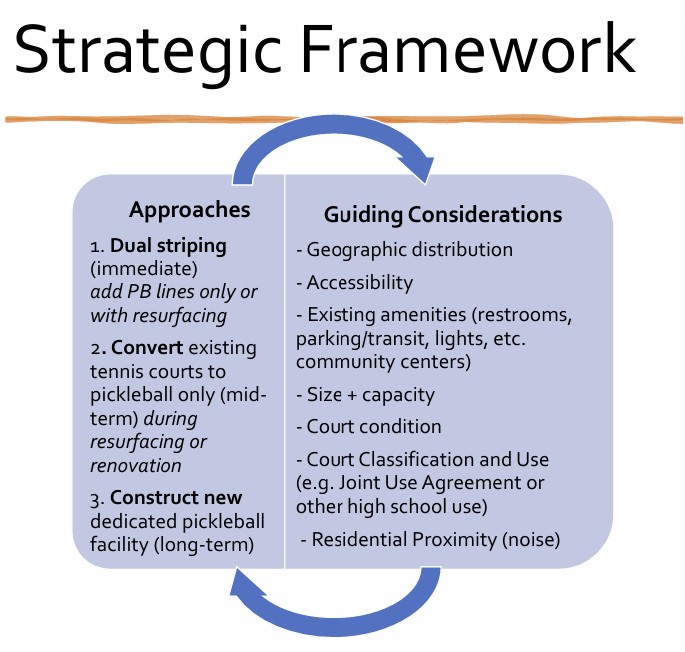
This "Strategic Framework" is part of Seattle Parks' 2021-2022 Outdoor Pickleball Study.
The short- and mid-term approaches consider existing tennis courts as public resources built and managed with public funds, and as such belonging to all residents. It is the Parks Department's duty to allocate this resource wisely, while considering both past use and current demand.
What is planned
The following table shows which specific sites are slated for short- and mid-term improvements.
| Site | Study Recommendation | Recommended Pickleball Court Addition |
| Alki Playground |
Dual stripe
Completed in 2022 |
4 |
| Bryant Neighborhood Playground | Dual stripe - Froula may be alternative | 4 |
| Froula Playground | Dual stripe - Bryant may be alternative | 4 |
| Garfield Playfield | Follow community-driven design process | |
| Gilman Playground |
Dual stripe
Completed in 2022 |
4 |
| Green Lake Park (West) | Dual stripe | 4 |
| Hutchinson Playground | Consider for conversion [to pickleball] with upcoming renovation | 5 to 6 |
| Kinnear Park | Correct with resurfacing - 2:1 | 1 |
| Laurelhurst Playfield | Dual stripe one battery | 4 |
| Madison Park | Use could be reconsidered with renovation | |
| Madrona Playground | Dual stripe | 4 |
| Meadowbrook Playfield | Dual stripe single battery with renovation | 6 |
| Montlake Playfield | Dual stripe | 4 |
| Observatory Courts | Full conversion of one court | 3 |
| Rainier Beach Playfield |
Dual stripe
Completed in 2022 |
8 |
| Ravenna Park | Consider conversion, dual stripe, and lights with renovation | |
| Ravenna Park (West / Cowen) | Consider conversion when renovating | |
| Riverview Playfield | Dual stripe | 4 |
| Seward Park | Dual stripe - or convert one court? | 4 |
| Solstice Park | Dual stripe one battery | 6 |
| Victory Heights Playground | Dual stripe | |
In addition, the study recommends adding lights to the courts located at Green Lake Park East and Magnolia Playfield.
What Actually Happened
Three of the proposed sites were striped for pickleball in 2022. Those sites were already slated for such work when the study was published. They are highlighted in green in the table above.
As of June 2025, not a single one of the other recommended improvements had taken place. This includes over 40 sets of pickleball court lines that were never drawn on existing tennis courts, as well as a few old tennis sites that were supposed to be converted to pickleball but never were. All those proposed but unrealized changes are highlighted in red in the table above.
As for adding court lights on existing courts as recommended by its own study, Seattle Parks has made no progress on that front either.
-
https://www.
seattle. gov/ documents/ Departments/ ParksAnd Recreation/ Projects/ Pickleball/ Pickleball Presentation ToBoard_ 20220811. pdf# page=13 -
https://www.
seattlechannel. org/ parksBoard/? videoid=x139051 - Spreadsheet from Seattle Parks' 2021-2022 Outdoor Pickleball Study, listing the study's short- and mid-term recommendations.
6
2023
USTA: Pickleball is a Critical Issue
The Chairman of the USTA board, Brian Hainline, emphasizes to the board of directors that "a two-year plan is needed to address critical issues such as pickleball."

Why would USTA consider pickleball to be a critical issue? Most likely because both private and public tennis facilities all over the country are lowering their tennis court inventory by:
- adding pickleball lines to existing tennis courts, and
- converting existing tennis courts to dedicated pickleball courts
2023
USTA: Tennis Courts are for Tennis Players
In February 2023, the USTA updated its "Statement of Guidance for the development, expansion, and renovation of public facilities and spaces related to tennis and pickleball."
This document promotes creating sport-specific sites as the ideal solution. In other words: leave the tennis courts for tennis players; build new courts for pickleball players.
The second option proposed by USTA is to create courts in non-traditional spaces, such as vacant parking lots. While the USTA presents this option as being available for both tennis and pickleball, the illustrations only show pickleball courts.
The third and final option, adding pickleball lines on existing tennis courts is presented as the option of last resort, with a lot of limitations: this should only be done on sites with two or fewer tennis courts, the pickleball lines should be of a color that blends with the playing surface, all pickleball lines should terminate three inches from the tennis lines, and so on.

It is telling that while USTA claims to have the support of "court builders and park professionals" for its guidance, it is unable to claim the support of any pickleball organization.
While this document talks "about having equitable offerings for both tennis and pickleball", its guidance is unequivocally steering Parks departments towards keeping tennis courts for tennis players. And if tennis courts have to be shared with pickleball players, it recommends that they be tennis courts first and foremost.
As for the specific options recommended, here is how they apply to Seattle.
- Building brand new pickleball-only courts is of course the ideal solution. While this is well and good in theory, Seattle Parks, like most urban Parks departments, does not have the financial resources necessary to create enough brand new dedicated pickleball courts to meet the existing or projected demand in a meaningful timeframe.
- Creating courts on non-traditional spaces was thoroughly examined by Seattle Parks around 2018, and no suitable locations were found.
- Seattle Parks followed the USTA guidelines of using "tone on tone" line color for adding pickleball lines on existing tennis courts when it first started adding pickleball court lines in 2017. The pickleball lines were very difficult to see under many conditions. Seattle Parks subsequently moved to a slightly more contrasting color scheme that still is far from optimal. Recently, Seattle Parks has started a "pilot" program where it uses high contrast pickleball lines on very specific tennis courts.
2
2023
USTA Wants to Combat the Effects of Pickleball
Craig Morris, USTA’s Chief Executive for Community Tennis presents a “multipronged approach to promote tennis and combat the effect of pickleball”.

Lew Sherr, Chief Executive Officer and Executive Director, explained that "the issue is not in and of itself pickleball [...], but the loss of tennis real estate [...]."

In January 2023, USTA recognized pickleball as a a critical issue. By March 2023, it is already reviewing a "multipronged approach" to "combat the effects of pickleball". Some of the root causes listed here are (1) the fact that some tennis courts are being used for pickleball, and (2) the fact that tennis coaches are getting certified to teach pickleball as evidenced by the Professional Tennis Registry (PTR) that now includes "5,000 certified pickleball pofessionals."
6
2023
SPR: Pickleball Striping Guidelines Include Meadowbrook and Solstice
In an internal email discussing pickleball lines color when adding pickleball court lines to existing tennis courts, Seattle Parks recommends that "Regional tennis courts", such as the Solstice and Meadowbrook courts, have blue or green lines.
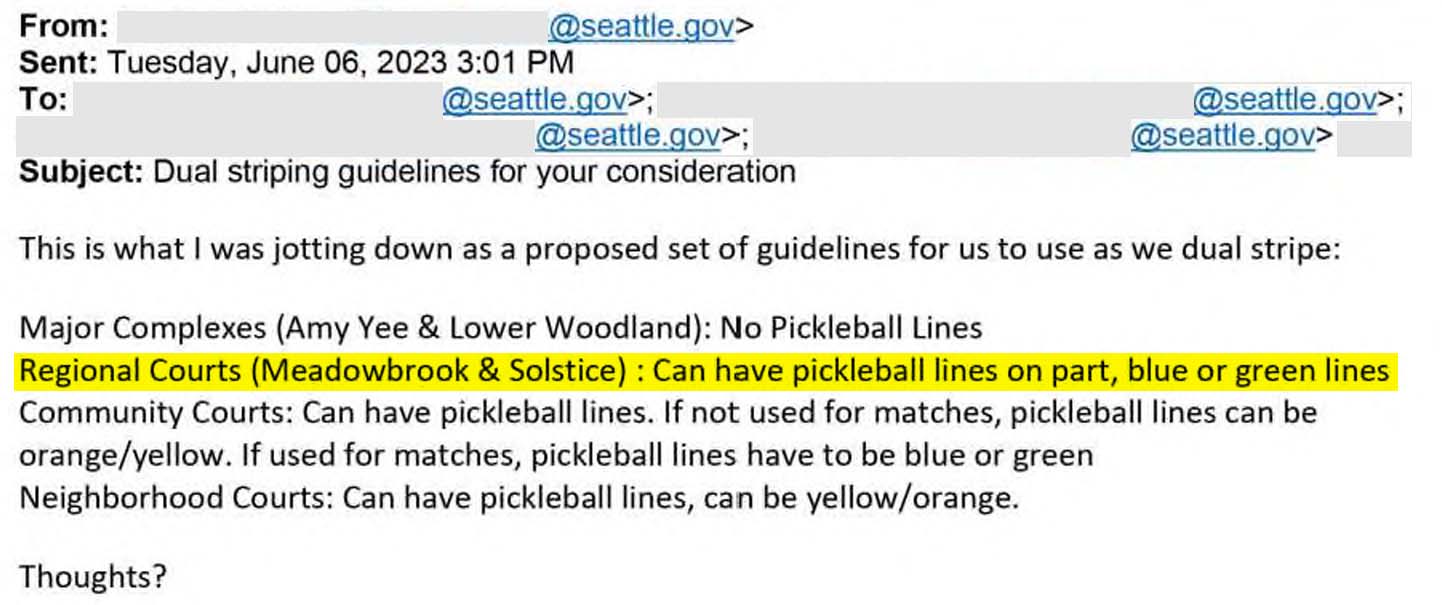
As of early June 2023, Seattle Parks still fully intended to follow up on its 2022 recommendation of adding pickleball court lines to some of its existing tennis-only courts, including Solstice and Meadowbrook.
23
2023
Arm, Defend, Protect: USTA Prepares for War
The USTA board reviews "the strategic priorities identified to both protect and grow court space in Parks and Recs."

Discussion ensues on "the need to develop services that position USTA as an advisor to help facilities grow and defend tennis-related investments."

They discuss ways to "arm advocates to protect against pickleball."

In March 2023, the USTA board of Directors considered a "multipronged approach" to "combat" the "effects of pickleball". In June 2023, they talk about arming, protecting, and defending. USTA is preparing to wage a covert war against pickleball.
The USTA talks about defending "tennis-related investments". Whose investments are those? The Seattle Parks' tennis courts were funded by public money. They are a community resource belonging to all Seattle residents.
23
2023
USTA Positions Itself as a Trusted Advisor to Parks Departments to Protect Against Pickleball
The USTA board reviews their strategy of becoming "a trusted partner for facilities and communities" and their priority "to both protect and grow court space in Parks and Recs."

Discussion ensues on "the need to develop services that position USTA as an advisor to help facilities grow and defend tennis-related investments."

They discuss "tools and plans for infrastructure advocacy" and ways to "arm advocates to protect against pickleball."

The USTA plans to wage war on two fronts:
- Position itself as an ally to Parks Departments (and other tennis facilities) and convince them to protect tennis courts.
- Arm tennis advocates to protect against pickleball.
Influencing public Parks Departments is crucial since
according to the National Recreation and Parks Association.
24
2023
USTA: Pickleball Growth Statistics Are Sobering
Liz McSorley, USTA’s Managing Director for Strategy and Innovation, provides “an overview of the market assessment […] on pickleball”. Among their conclusions:
- “Pickleball has reached critical mass and its impact cannot be ignored.”
- "Major tennis stakeholders have invested in Pickleball and are committed to growing it."
- "Pickleball poses two key risks to tennis growth, by reducing the supply of courts and impacting the demand for tennis by players."
- Pickleball growth is impacting tennis stakeholders: "broadcasters, tennis retailers, coaches and facilities have embraced pickleball to drive engagement and to diversify revenue streams."
- The pickleball growth statistics are "sobering."

The USTA realizes that pickleball not only affects the availability of public and private tennis courts but it is also a threat to USTA's own existence: About 90% of USTA's revenue comes from the US Open tennis tournament. Tennis players and stakeholders embracing pickleball threatens that revenue stream.
24
2023
USTA: "It is Imperative that Youth Start in Tennis" [As Opposed to Pickleball]
The USTA has a long term goal of increasing the number of tennis players from 23 million in 2023 to 35 million players by 2035.
The USTA sees every young new pickleball player has someone who might have enjoyed tennis but is being lost to pickleball. Therefore, they see it as extremely important that youth start by playing tennis rather than pickleball.

The USTA sees itself competing with pickleball for new players. It recognizes that young pickleball players are unlikely to transition from pickleball to tennis. It therefore wants to ensure that young players start by playing tennis rather than pickleball.
While this might be a fine objective for the USTA, is it suitable for Parks Departments across the nation to adopt it as well? Should they partner with associations whose goals might be at odds with those of their residents?
2023
USTA conducts a "Park Agency Tennis Assessment" of SPR's Tennis Program
Representatives of the United States Tennis Association (USTA) hold several meetings with the Seattle Parks Department (SPR) to assess SPR's tennis program. Unsurprisingly, this assessment addresses pickleball as well, since public outdoor pickleball is played mainly on tennis courts in Seattle. The first such meeting occurs on May 11, 2023, and four more take place over the summer.

In Seattle, most public outdoor pickleball courts are shared with tennis players and fall under the purview of Seattle Parks' Amy Yee Tennis Center. Those pickleball courts shared with tennis players are therefore subjected to the USTA's assessment.
What is the likelihood that the USTA, a TENNIS association evaluating a TENNIS program, is going to make recommendations that are going to fairly treat pickleball players using dual-used tennis courts?
What is the likelihood that the USTA, a tennis association that views tennis courts as needing to be defended and protected from pickleball players, is going to make recommendations that are going to fairly treat pickleball players?
2023
USTA's Tennis Advocates Attack
A petition gathers 1,500 signatures under the false premise that "a proposal has been brought forth to put pickleball lines on half of the 10 tennis courts at Lower Woodland in Seattle."
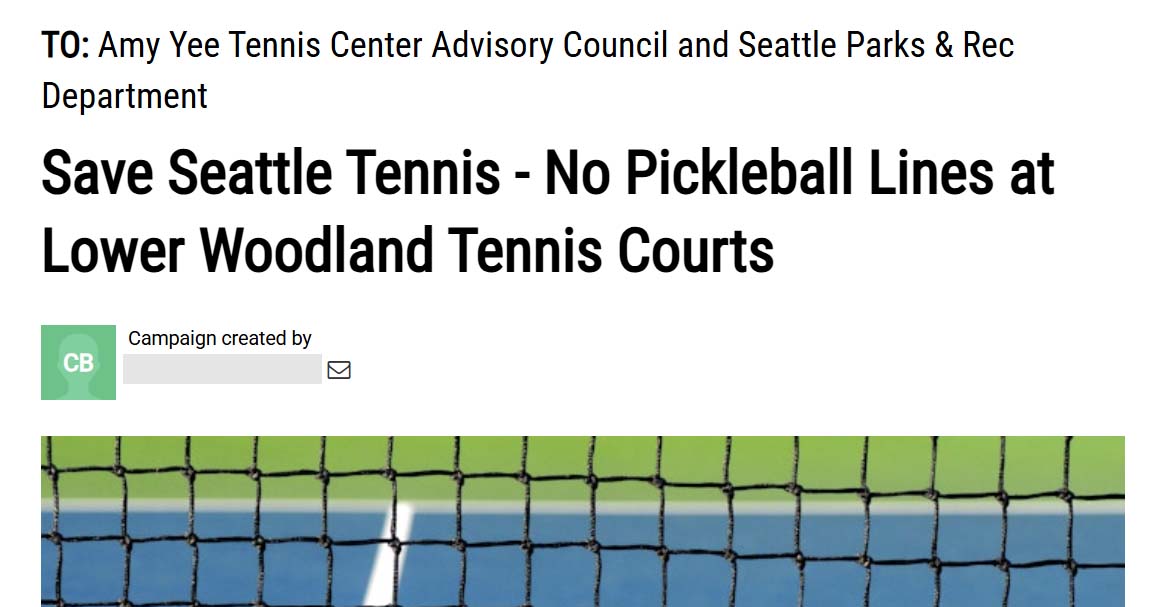
The ten lighted Lower Woodland tennis courts see very little use during the evenings between October and March. The six Green Lake pickleball courts see heavy use every evening, but since they don't have any lights, play cannot proceed past sunset.
To illustrate this point, the video below shows the busy Green Lake Pickleball courts right before sunset at 4:30pm on January 14, 2024, followed by the near empty Lower Woodland tennis courts a minute later.
No creditable pickleball group has ever proposed that half of the Lower Woodland Park courts should be lined for pickleball. Yet that disinformation was used to gather signatures opposing a made up proposal.
Pickleball players have been asking for access to two of the existing ten lighted Lower Woodland pickleball courts during the evenings from October to March, but that would in no way take court time away from tennis players: Tennis is only rarely played on, at most, two or three of the ten lighted courts on winter evenings.
In June, the USTA set the goals to protect court spaces in Parks and Recs, defend tennis-related investments, and arm advocates to protect against pickleball. This petition certainly looks like the USTA is setting its machinery in motion to achieve those goals.
27
2023
Seattle Parks Internal Memo:
Immediate Tennis Court Conversion Project
An internal memo from Seattle Parks "outlines the preliminary list of tennis courts that can be converted to dedicated pickleball courts including estimated conversion costs, selection criteria, site specific issues and considerations, scope of work, approach, and assumptions on how the project could proceed, and community engagement plan to guide immediate conversion of the tennis courts into dedicated pickleball courts."
It notes:
- "The first step is to select possible best sites that will have the least impact on tennis users"
- "We could realistically do 3 sites this year"
- The three priority sites that can be converted with minimum complications this year are likely Georgetown Playfield, Observatory Courts, and Lincoln Park or Ravenna Park (subject to further site assessment).
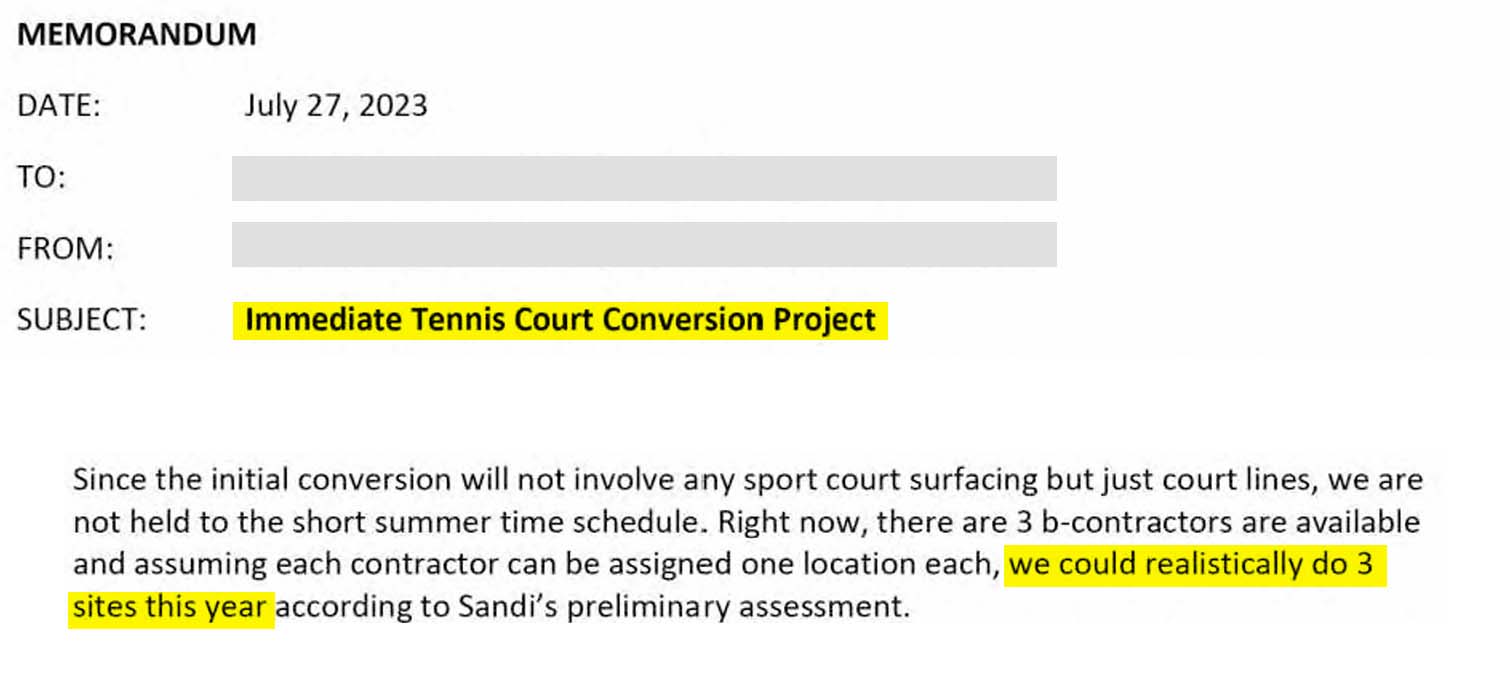
Seattle Parks plans for the "immediate" conversion of a few shared or underutilized tennis courts into dedicated pickleball courts. It identifies six candidate locations and is confident that it can deliver on three of them before the end of the year.
Unfortunately, Seattle Parks will end up not converting any of those six courts during that summer or the following one. As of June 2025, a third summer is upon us and no progress has yet been made.
What happened? How did SPR go from "immediate tennis court conversion" to no conversion at all? Could it be that the USTA "saved" those courts from being converted?
29
2023
Seattle Mayor: "We Need More Pickleball Courts"
In 2023, Pickleball saw a 51.8% annual increase in participation according to the Sports and Fitness Industry Association (SFIA). Yet, Seattle Parks created no new pickleball courts.
In 2024, Pickleball saw a 45.8% annual increase in participation according to the SFIA. Once again, Seattle Parks created no new pickleball courts.
There is every reason to believe that pickleball participation continues to increase at a rapid pace in 2025, yet Seattle Parks seems to be poised to create no new pickleball courts during the course of the year.
Seattle Mayor Bruce Harrell is running for re-election, facing seven challengers in the August 5, 2025, primary, with the top two advancing to the November 4 general election. Your voice can and should be heard.
- “We Need More Pickleball Courts. I Get It. I Hear You.” – Bruce Harrell
- Pickleball Continues Unprecedented Growth in Every Age Group and Region for Third Straight Year, Significant Investments Still Needed for Court and Facility Demand, November 14, 2024
- SFIA Releases Single Sport Reports for Pickleball and from the Team Sports Category, May 14, 2025
1
2023
SPR: More Courts on the Way
In a radio interview with Kim Shepard aired on August 1st, 2023, on KNWN, Seattle Parks' Rachel Shulkin says:
"We have more courts on the way. We are doing a lot of additional striping at courts throughout the city. And we are working on plans to create a dedicated outdoor pickleball facility."
Rachel Schulkin, Seattle Parks and Recreation
"We are a major metropolitan city, one of the fastest growing metropolitan cities, and Seattle is not going to grow in terms of geographic space, and so we really do have to share. It is just like our athletic fields: people are playing frisbee, they are playing football, they are playing lacrosse, they are playing soccer, all on the same field. That just has to be the reality for some of the ways we play sports in this city."
Rachel Schulkin, Seattle Parks and Recreation
While Seattle Parks may have plans to create dedicated pickleball courts, Rachel Schulkin stresses that Seattle Parks is planning to add pickleball lines to more existing tennis courts so they can be used for both tennis and pickleball. She explains that just like Seattle’s athletic fields are shared by soccer, frisbee, football, and lacrosse, Seattle's sport courts should be shared too, so everyone has a chance to play.
Imagine what would happen if each sport's national governing body required that amateur games be played on fields dedicated to their own sport. Sports with smaller followings or seasonal dips could see their fields sit empty while others scramble for space. Emerging and fast-growing sports like ultimate frisbee would struggle to find a foothold as they would be denied access to existing fields.
3
2023
SPR: Three Tennis Courts at Solstice Park Will be Dual Striped for Tennis and Pickleball
In its Amy Yee Tennis Center Summer Newsletter, Seattle Parks announces that "3 courts at Solstice Park will be dual striped for tennis and pickleball."
Solstice Park has two banks of three tennis courts, or a total of six lighted tennis courts. The Seattle Parks department is planning to resurface all six tennis courts and add pickleball court lines on one bank of three tennis courts.
While this particular announcement occurred in August, the decision was made months earlier. The Seattle Metro Pickleball Association (SMPA) for instance had been aware of this plan since February.
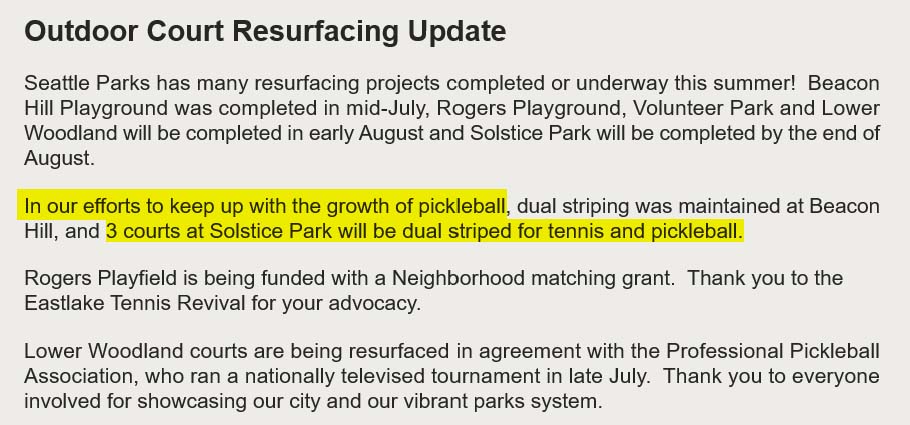
Solstice Park is located in West Seattle and has six tennis courts with lights. According to Seattle Parks' own data, these courts have modest tennis usage.
West Seattle tennis players have access to 11 lighted courts in three West Seattle locations, 2 of which are shared with pickleball players. West Seattle pickleball players have access to four lighted pickleball courts, all of which are shared with tennis players.
Adding pickleball lines to three of the six Solstice Park tennis courts would provide a new location for pickleball evening play. It would also more than double the number of lighted pickleball courts that are shared with tennis players.
| West Seattle Existing Lighted Courts | ||
| Dedicated | Shared | |
| Tennis | 9 | 2 |
| Pickleball | 0 | 4 |
| West Seattle Proposed Lighted Courts | ||
| Dedicated | Shared | |
| Tennis | 6 | 5 |
| Pickleball | 0 | 10 |
- Amy Yee Tennis Center Summer 2023 Newsletter
-
List of public outdoor tennis courts owned by Seattle Parks:
https://www.seattle.gov/
parks/ rentals-and-permits/ sports-fields/ tennis-courts
14
2023
Tennis Advocates Come to Protect Tennis Courts Against Pickleball
During the first nine days after Seattle Parks officially announced that it was going to add pickleball lines to three of the six pickleball courts, Seattle Parks does not receive a single email on the subject from tennis players.
On the tenth day, tennis players start sending emails to the same six Seattle Parks employees, giving them their feedback regarding Seattle Parks plans for the Solstice tennis courts.
This email campaign might have started when someone impersonating Parks department officials posted an announcement on the Solstice tennis courts asking people to let Seattle Parks know "your thoughts on sharing these tennis courts with pickleball players, if you have any concerns regarding noise, or other concerns." Seattle Parks eventually removed the notice. Seattle Parks' Samantha Burton reflected in an email "There's a lot of issues with that sign— impersonating gov’t and city official..."
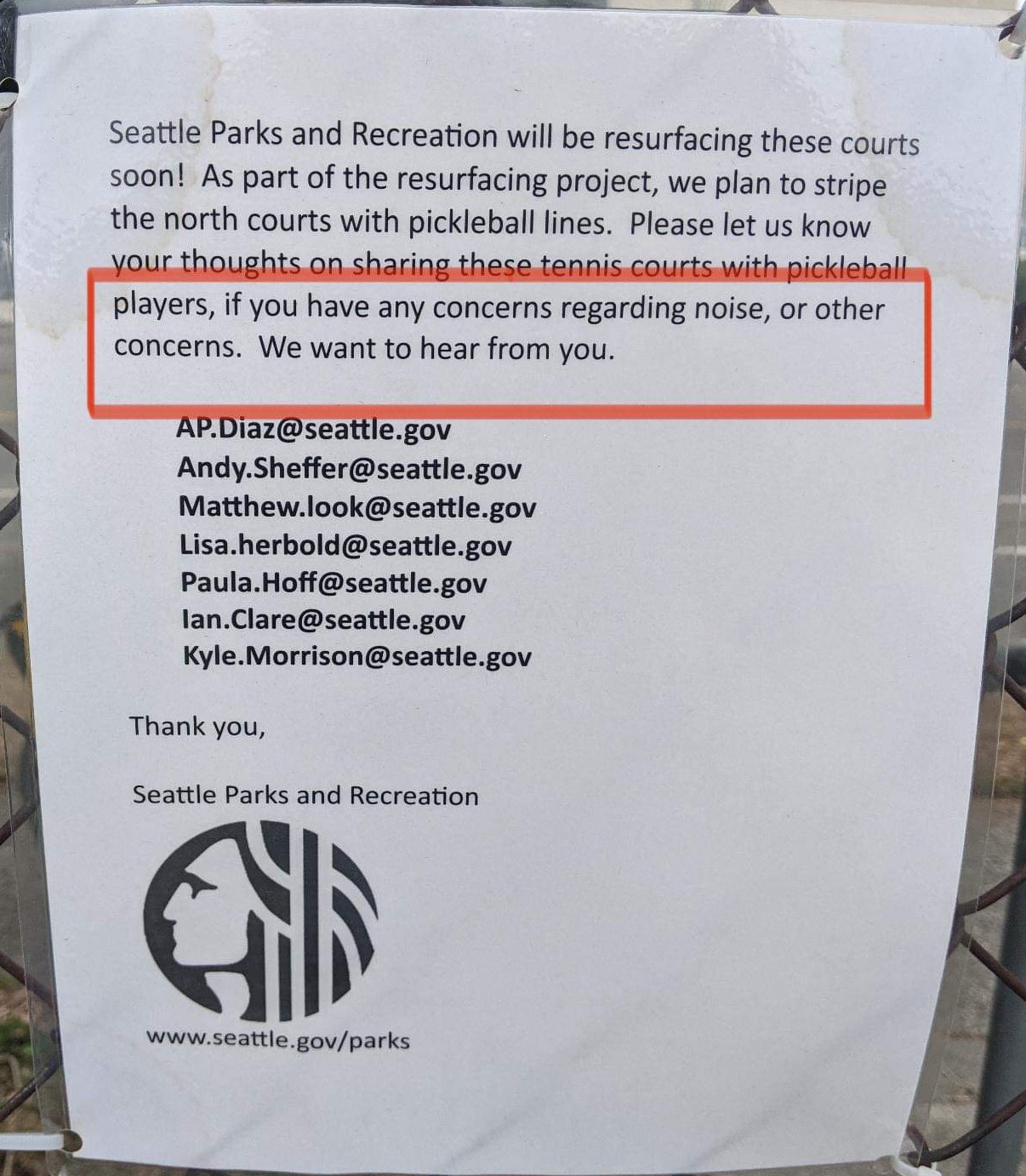
A Single Orchestrated Campaign
Starting August 14 and then over several days, about sixty tennis players email Seattle Parks to let them know their thoughts on sharing "their" courts with pickleball players. Since most of those emails are sent to all or most of the recipients listed on the fake Seattle Parks flyer posted on the courts, they are likely all part of a single orchestrated campaign.
It seems very unlikely that they would be a direct response to Seattle Parks' August 3rd announcement of its plan to add pickleball lines to three of the six Solstice pickleball courts or to the August 10th news article posted on the subject by the West Seattle blog.
Pickleball Players Yet Again Excluded From the Process
This orchestrated campaign is a potent weapon in the arms of the tennis players, because pickleball players are largely unaware of its existence and fail to counter it by getting their own voices heard.
Who Is Behind the Campaign?
Is the United States Tennis Association (USTA) linked to this campaign? So far, we have no proof one way or the other. But this campaign certainly aligns with the USTA's stated goal to "arm [tennis] advocates to protect against pickleball."
30
2023
SPR Holds Preliminary Report from USTA
Mayor's Office Apparently Looped Into Review
The SPR superintendent, AP Diaz, asks that Dan Eder be "looped" into the USTA assessment. He writes "Can you share the report that was sent to us; let him know it's preliminary and then invite him to participate in the meeting we are going to have to debrief the report."

Seattle Parks was in possession of a preliminary version of the USTA's Seattle Park Agency Tennis Assessment and was aware of USTA's recommendations as of August 30 or before.
While we don't officially know who the person being looped in is,
it is likely he is the same Dan Eder who was at the time the mayor's
policy director
and happens to be a
solid tennis player.
This raises a few questions. Was Dan Eder asked to review the USTA
recommendations in his capacity as the mayor's policy director?
If so, did he approve these recommendations even though
they call for
removing lines for 38 planned and existing pickleball courts
and even though the mayor had publicly said a few weeks earlier that
Seattle needs more pickleball courts?
If Seattle Parks' superintendent looped Dan Eder into the USTA assessment
as a private citizen,
it would be interesting to know how many pickleball players
the superintendent looped in as well.
So far, we don't know of any.
14
2023
SPR Cancels Solstice Pickleball Plans
In an email sent to sixty-four tennis community members, Seattle Parks announces that it is reversing its decision to paint pickleball court lines on three of the six lighted Solstice Park tennis courts.
It announces that it will create six unlighted dedicated pickleball courts on two long-abandoned tennis courts at nearby Lincoln Park instead.
To: PKS_Info <pks_info@seattle.gov>
Bcc: ░░░░░░░@gmail.com, ░░░░░░░@gmail.com, ░░░░░@░░░░░░░░░░░░░.com, ░░░░░░&#@msn.com, ░░░@░░░░░░░░░.org, ░░░@░░░░░░░░░░.us, ░░░░░░░░@gmail.com, ░░░░░░@gmail.com, ░░░░░░░░░░░░░@gmail.com, ░░░░░░░░░░░░░@yahoo.com, ░░░░░░░░░░@comcast.net, ░░░░░.░░░░░░░░░@comcast.net, ░░░░░░░░░░░@gmail.com, ░░░░░░░░░░░░░░@outlook.com, ░░░░░░░░@gmail.com, ░░░░░░░░░@comcast.net, ░░░░░░░░░░░@gmail.com, ░░░░.░░░░@gmail.com, ░░░░░░░@gmail.com, ░░░░░░░░░░░░░@gmail.com, ░░░░░░░░░@gmail.com, ░░░░░░░░░░░░@hotmail.com, ░░░░░░░░░░░░░░@gmail.com, ░░░░░░░░░░░░░@yahoo.com, ░░░░░░░░@gmail.com, ░░░░░░░░░░░@yahoo.com, ░░░░░░░░░░░░░░░@comcast.net, ░░░░░░░░░░░░░░@yahoo.com, ░░░░░░░░░░░░@gmail.com, ░░░░░░░░░@comcast.net, ░░░░░░░░░░░░@yahoo.com, ░░░░░░░░░░░░@gmail.com, ░░░░;.░░░░░░@░░░░.com, ░░░░░░░@gmail.com, ░░░░░░░@yahoo.com, ░░.░░░░░░░░░░@outlook.com, ░░░░░░░░░░░░░@gmail.com, ░░░░░░░░░░@me.com, ░░░░░░░░░░░░░@comcast.net, ░░░░░░░░░░░░░@gmail.com, ░░░░░░░░░@hotmail.com, ░░░░░░░@comcast.net, ░░░░░░░░░░░░░░@gmail.com, ░░░░░░░░@comcast.net, ░░░░░░░░@comcast.net, ░░░░░░░░░@hotmail.com, ░░░░░░@live.com, ░░░░░░░@hotmail.com, ░░░░░░░░@gmail.com, ░░░░░@░░░░░░░░░░.com, ░░░░░░░░░░░░░░░░░░@gmail.com, ░░░░░░░░░░@hotmail.com, ░░░░░░░░░░░░░░@gmail.com, ░░░░░░.░░░░.░░@gmail.com, ░░░░░░░░░@aol.com, ░░░░░░░░░@hotmail.com, ░░░░░░░░░░░░░░@yahoo.com, ░░░░░░░░░░@gmail.com, ░░░░░░░░@░░░░░░░░░░.com, ░░░░░░░░░░@gmail.com, ░░░░░.░░░░░░░░@gmail.com, ░░░░░░░░@░░░░░░░.com, ░░░░░░░@yahoo.com, ░░░@me.com
Date: Thu, 14 Sep 2023 16:24:19 -0700
Subject: Update about Solstice Park Dual Striping from SPR
Dear Community Members:
We greatly appreciate the robust feedback received about dual striping at the Solstice Park tennis courts.
The department is pleased to announce the creation of a dedicated pickleball court at Lincoln Park, keeping the Solstice Park tennis courts intact as a dedicated tennis site with no dual striping.
[...]
Thank you,
Samantha Burton (she/her)
Communications Administrative Staff Analyst
City of Seattle, Seattle Parks and Recreation
Timeline
Let's summarize a few of the events that led us here.| Mar 2 | USTA declares it wants to combat the effects of pickleball. |
| Jun 6 | SPR's pickleball striping guidelines include the Solstice Park tennis courts. |
| Jun 23 |
USTA positions itself as a trusted advisor to Parks Departments nationwide.
USTA's intention is to protect tennis courts against pickleball. |
| Summer | USTA conducts a "Park Agency Tennis Assessment" of SPR's Tennis Program. |
| Aug 3 | SPR announces that three of the six lighted tennis courts at Solstice Park will be dual striped for tennis and pickleball. |
| Aug 30 | USTA has delivered a preliminary Park Agency Tennis Assessment report to SPR. |
| Sep 14 |
SPR cancels its plan of adding pickleball court lines to three of the six Solstice tennis courts.
SPR proposes creating unlit dedicated pickleball courts at Lincoln Park instead, but this new plan will quickly fizzle out and be canceled as well. |
USTA Scores
USTA made it abundantly clear in their recommendations to SPR that they did not want to have pickleball court lines painted on any of the six Solstice Park tennis courts, or at any tennis location with three or more courts.
This decision by SPR is music to USTA's ears.
Ivory Tower Decisions
Pickleball players and their local organization were never consulted.
Pickleball players never got a chance to point out that trading 6 lighted shared courts for 6 unlighted dedicated courts was not necessarily an even trade when the demand for lighted pickleball courts is so much higher than the supply.
Constituent Engagement Shmengagement
This announcement was sent to 64 people advocating for tennis. It was not sent to a single a pickleball advocate, not even to the Seattle Metro Pickleball Association. Pickleball players found out about this through the local press.
Unkept Promises
Seattle Parks announced that it was going to quickly create six unlighted dedicated pickleball courts at nearby Lincoln Park. That project was soon abandoned.
19
2023
USTA Releases its Seattle Park Agency Tennis Assessment Recommendations
This is the final version. An earlier version had already been circulated through the Parks department.
Among other things, USTA promotes its Statement of Guidance which we already know deems pickleball lines on tennis courts a solution of last resort to be used only on sites with two or fewer tennis courts.
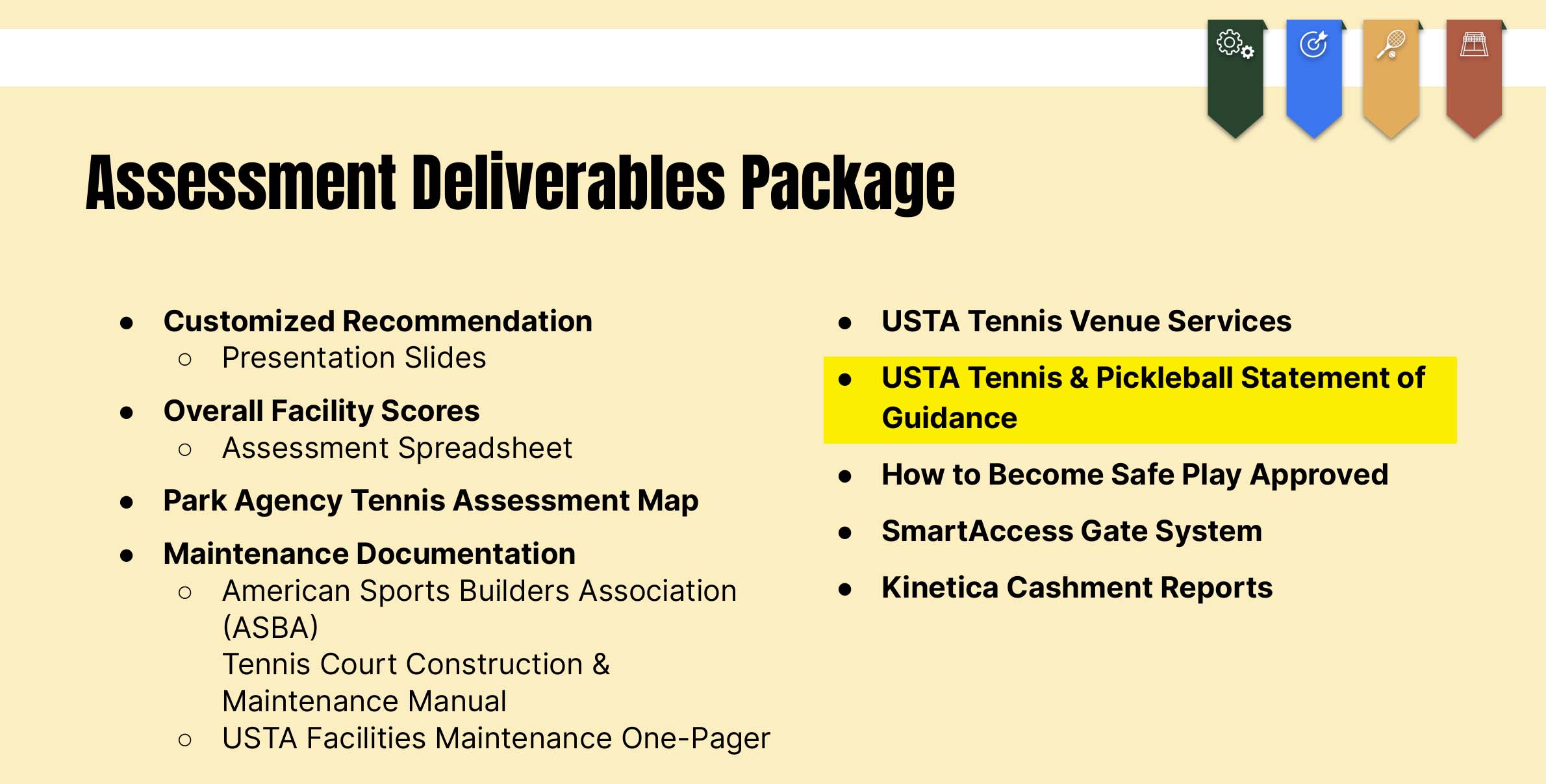
USTA also recommends removing pickleball lines when resurfacing tennis courts, especially at courts with more than two tennis courts.
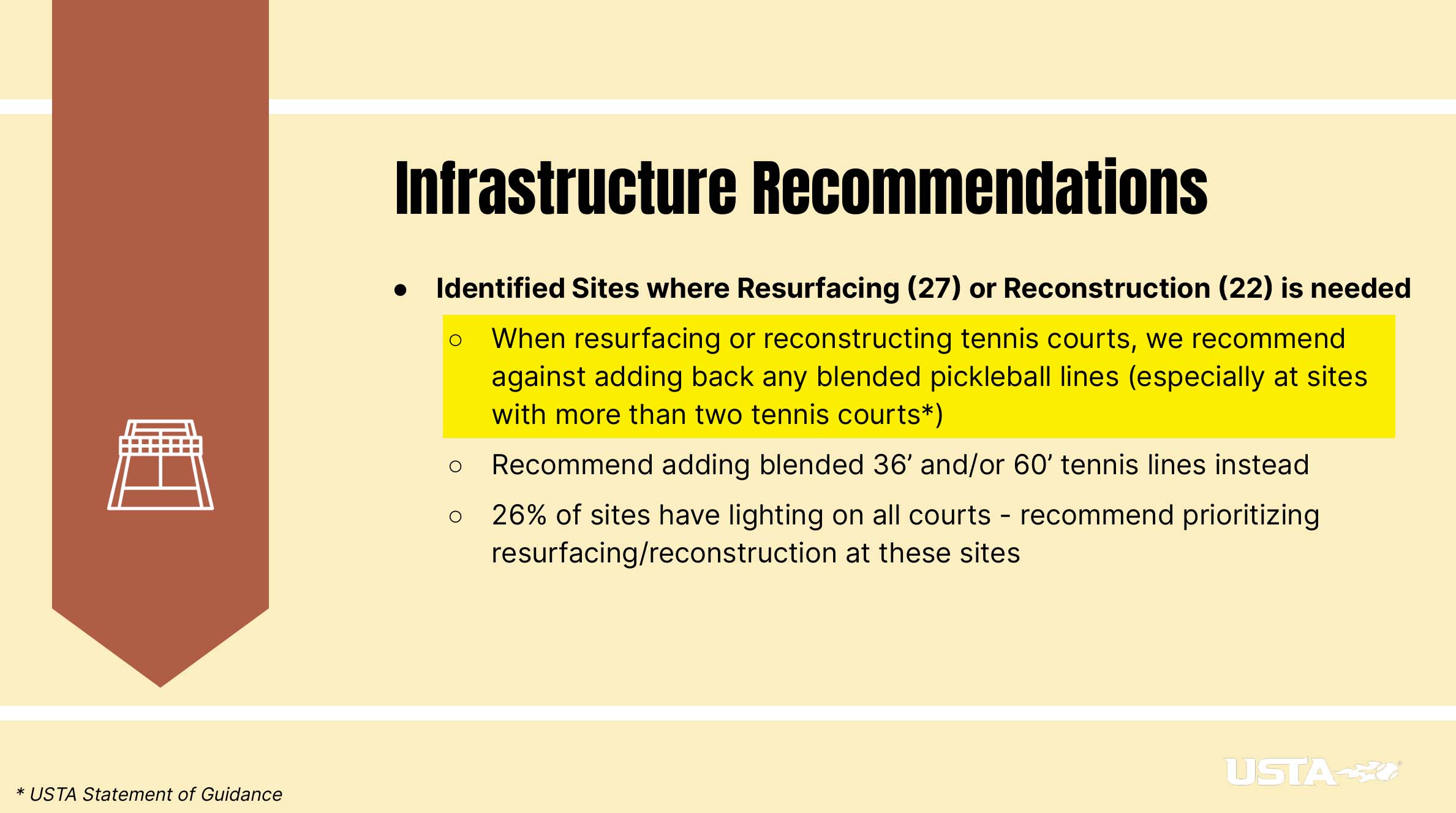
USTA estimates that 50% of the sites might be underutilized
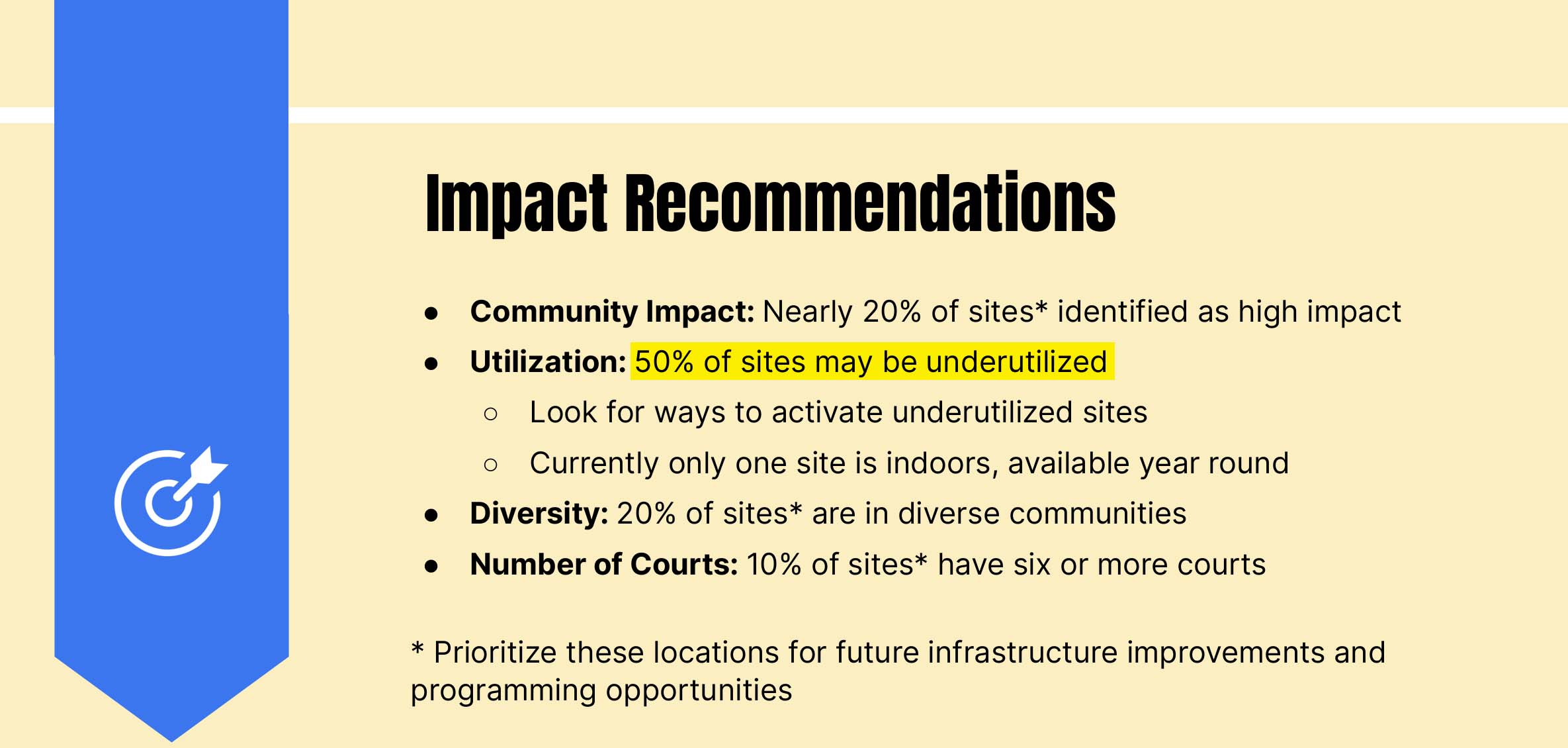
USTA ranks the Amy Yee and Lower Woodland courts the highest overall.
USTA ranks the Amy Yee and Lower Woodland courts the highest overall.
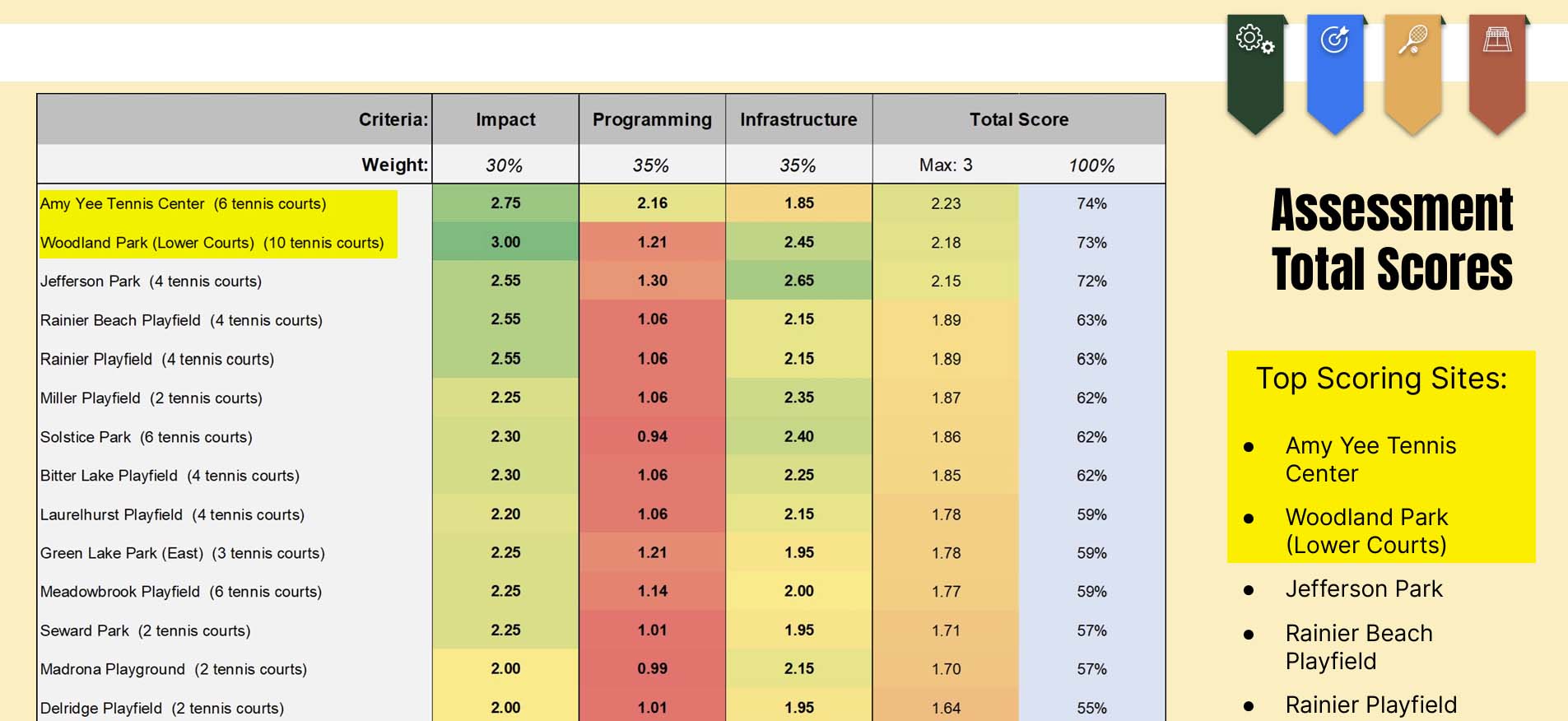
USTA Recommends Removing Lines for 38 Planned and Existing Pickleball Courts
The implications of these recommendations for Seattle pickleball players are staggering.
Clearly, adding lines for six pickleball courts on three of the six Solstice Park tennis courts as SPR had planned to do would violate these recommendations.
And if Seattle Parks were to follow those recommendations, they would also erase pickleball court lines from the Bitter Lake (8), East Green Lake (8), Magnolia Playfield (8), and Rainier Beach sites (8), as those courts get resurfaced over the years.
Meanwhile 50% of the Sites are Underutilized
Here is another shocker: USTA wants to get rid of pickleball lines on tennis courts, but at the same time points out that "50% of sites might be underutilized".
22
2023
USTA Helps Prioritize SPR Courts to be Resurfaced in 2024 and Beyond
Seattle Parks has a single budget item that covers the maintenance and resurfacing of public outdoor tennis and pickleball courts.
How would you fairly allocate this budget between the two sports?
In September 2023, Seattle Parks let the United States Tennis Association guide the selection of courts to be resurfaced in future years.
Interestingly, in 2024, all courts that were resurfaced were tennis-only courts. No courts with pickleball lines were resurfaced.
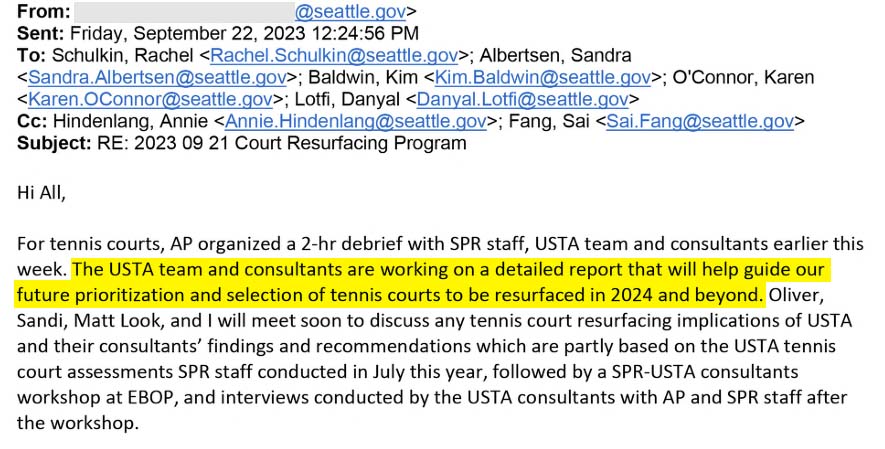
Seattle Parks has about 92 tennis courts dedicated to tennis and an additional 44 tennis courts col-lined for pickleball.
In 2023, 17 tennis-only courts were resurfaced, as well as 2 tennis courts that have pickleball lines.
In 2024, all the tennis courts that were resurfaced were tennis-only courts. No tennis court with pickleball lines were resurfaced.
As for 2025, the court resurfacing plan of record as of June once again includes no court with pickleball court lines.
Why is Seattle Parks inviting the USTA to help guide the prioritization and selection of which tennis and pickleball courts should be resurfaced? Is it any surprise that such guidance is leading to recommendations that blatantly favor tennis players over pickleball players? Why hasn't Seattle Parks invited the Seattle Metro Pickleball Association to the planning table? How is this equitable?
Could it be that having USTA consult with your city's Park department introduces bias in favor of tennis?
- 2023 Tennis and Pickleball Court Resurfacing, seattleinapickle.com, August 4, 2023
- Implementation of the 2022 Outdoor Pickleball Study and the 2024 Seattle Parks & Recreation Pickleball and Tennis Vision, parkways.seattle.gov, May 30, 2024.
- SPR Internal Email PKS C155344 02 00074 obtained through Public Records Request.
5
2023
Seattle Parks Abandons Dual-Line Policy
For the past six years, Seattle Parks had been declaring that it did not have any money to spend on pickleball. The only support it could offer was to paint pickleball court lines on the most underused tennis courts.
On this day, Seattle Parks abandons this meager support because of reported friction between pickleball and tennis players at shared courts.
From: <░░░░░░░░@
To: Eric Gold <ericg@
Date: Fri, 06 Oct 2023 17:04:05 -0700
[...]
Several staff reported about the friction between pickleball and tennis players at shared/blended courts. In order to reduce this friction SPR will not be converting additional tennis courts as shared/blended one and instead focus on dedicated tennis or pickleball courts.
[...]
USTA's Fingerprints Are All Over This Decision
We already know that the United States Tennis Association (USTA) was deeply concerned about the loss of tennis real estate as expressed in their March 2, 2023, Board meeting.
This decision by Seattle Parks to stop turning (underused) tennis courts into tennis courts shared with pickleball is exactly what USTA wanted all along.
We also know that USTA wanted:
- to combat the effects of pickleball , and
- to position itself as a trusted advisor to parks departments to protect against pickleball which it did when it conducted a "Park Agency Tennis Assessment" of Seattle Parks' Tennis Program during the summer of 2023.
Is it pure coincidence that this decision, made after a whole summer-long lobbying effort by USTA, is just what USTA was hoping for?
The Pickleball-Side of the Story
Who among the "roomful of SPR staff" briefing the superintendent was there to report the pickleball side of the story? Most likely, no one. Seattle Parks has a history of making major decisions affecting pickleball players without having any pickleball players present when the decision is made. Somehow tennis players' representation is always assured.
How Much Friction?
When occasionally friction occurs, some people complain. When no friction occurs, nobody notices. Where there are people there will always be friction. To justify this decision as being due to friction between tennis and pickleball players, Seattle Parks should have made an effort to find out what proportion of all interactions result in friction, but they didn't.
Friction by Design
Seattle Parks' court design policies and court usage rules were created to maximize tennis court rental revenue. They were not created to minimize friction nor to maximize the use of the courts by as many people as possible.
It is by design that tennis and pickleball players have to play side-by-side, even though it upsets the more serious tennis players, and it makes poor use of the available real estate as far as pickleball courts are concerned. Seattle Parks could have decided to design dedicated hours for each sport. Or, it could have decided to give pickleball priority on the shared courts since there are usually many tennis-only courts nearby any Seattle shared court, but there are rarely any alternate pickleball courts within reasonable distance.
It is by design that the tennis players are allowed to reserve or claim one of the tennis courts that have pickleball lines on them, even if there are plenty of empty tennis-only courts nearby.
It is by design that Seattle Parks' public indoor pickleball court-usage rules require equitable sharing of the courts through open play, while its public outdoor pickleball court rules hinder equitable sharing of the courts through open play.
Separate But Unequal
Until now, Seattle Parks' only answer to pickleball's growth had been to add pickleball lines to mostly underused tennis courts. This decision to stop adding pickleball court lines to additional tennis courts means that there will be extremely few if any new public places to play pickleball in Seattle in the foreseeable future. Meanwhile the number of pickleball players keeps growing at a vertiginous rate.
According to the Washington State Recreation and Conservation office there were already about as many pickleball players as tennis players in Seattle/King County in 2022. Since then, the number of local pickleball players is bound to have largely surpassed the number of tennis players. Yet, Seattle Parks by all measures keeps blatantly favoring tennis over pickleball.
Hiding Policy Changes for the Greater Good
Shouldn't public policy changes be made public?
If so, through which public channel was this radical policy change announced? None to our knowledge.
You too, Consultants?
You may have noticed that two of the email recipients are part of Broadview Planning, a "consulting firm specializing in community planning and public engagement services that promote health, sustainability, and equity" who believes that "there is always a better way to connect with stakeholders".
Are the consultants hired by the Seattle Parks Department neutral parties or are they also biased in favor of tennis?
- SPR Internal Email PKS C155344 02 00062, obtained through Public Records Request.
- Pickleball Sees Unprecedented Growth, sfia.org, August 10, 2023.
- State of Washington 2022 Assessment of Outdoor Recreation Demand Report, Washington State Recreation and Conservation Office, August 2022.
8
2024
USTA Follows up on its Assessment of SPR Tennis (and Pickleball)
In early 2024, USTA requests a meeting to check on how SPR is following up on the USTA recommendations delivered in September 2023.
SPR prepares for the meeting in February and March, and the meeting takes place on April 8th.

Six months after recommending (1) that Seattle Parks stop adding pickleball court lines on existing pickleball courts, (2) that Seattle Parks remove pickleball court lines painted at any location that has 3 or more tennis courts, and (3) that Seattle Parks refrain from converting any underutilized tennis courts into dedicated pickleball courts, the USTA keeps up the pressure to make sure at least some of its recommendations are being implemented.
8
2024
Seattle Parks Superintendent Cozies Up to the USTA
From: AP.Diaz@
"Where and when is the USTA Annual Meeting this year?"
From: todd.carlson@
"It is in Orlando starting this Friday. Will you be in town?"
From: AP.Diaz@
"Bummer. Maybe next year I could participate or speak?"
From: todd.carlson@
"Yes. Definitely."
The Seattle Parks superintendent has every right to speak at the USTA annual meeting. The Seattle pickleball players have every right to question whether the superintendent can treat them fairly while also having a cozy relationship with the one organization that considers pickleball a "critical issue" and has developed strategies to "combat" it.
10 or 11
2024
USTA: Six Hundred Tennis Courts Saved
Almost a year after they decided (1) to pretend to be an ally to Parks Departments (and other tennis facilities) and convince them to protect tennis courts, and (2) to arm tennis-advocates to protect against pickleball, the USTA reports its success: Six hundred courts have been impacted or saved to date through advocacy efforts.

Nationwide Impact
Obviously, USTA did not save 600 tennis courts in Seattle alone. This was a nationwide effort.
At the National Recreation and Parks Association annual conference in October 2024, the USTA reported that it has completed eleven Park Agency Tennis Assessments, and had a few more in progress. It lists the following cities under "recently completed assessments:"
- Dallas, TX
- Columbus, GA
- Chattanooga, TN
- Moore, OK
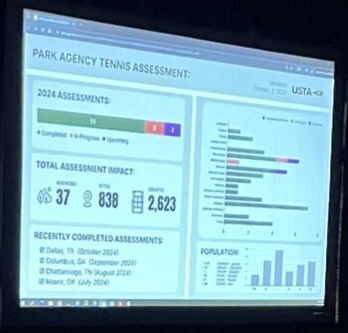
Seattle Impact
Count among those 600 impacted or saved courts:
- Seattle's three Solstice Park tennis courts that were slated to be shared with pickleball, but no longer are.
- A few other Seattle tennis courts that could have been graced with pickleball lines to keep up with demand but are now reserved exclusively for tennis as Seattle Parks abandoned its short-term goal of adding pickleball lines to existing tennis courts .
- The few neglected tennis courts that Seattle Parks had considered converting to pickleball in the mid-term.
13
2024
Seattle Parks Institutes Lower Woodland Park and Amy Yee Tennis Center as First Dedicated Outdoor Tennis Hubs
In May 2024, Seattle Parks designated the outdoor courts at Lower Woodland Park and at the Amy Yee Tennis Center as Seattle's first locations dedicated as "hubs" for the sport of tennis.
According to Seattle Parks, "This means these courts will only be used for the play of tennis."
But these courts had already been designated for exclusive tennis use for as long as people can remember. So, why did Seattle Parks feel the need to re-designate them as "exclusively for tennis use"?

Is this just a way to cement the tennis community's hold on what the USTA deemed to be their "top scoring" sites?
Is this SPR signaling to the tennis community that it will continue to offer them undue privilege?
Is this a meaningless act or is it absolutely necessary because SPR needs a way to justify their refusal to allow pickleball players to access two of the ten Lower Woodland tennis courts during winter evenings? They have justified blocking pickleball players from this valuable public resource by stating that the USTA will not sanction tournaments at Lower Woodland Park if these courts are also lined for pickleball. This assertion turns out to be false.
- Seattle Parks' Tennis page on Seattle Parks' Engagement Hub. Retrieved, June 24, 2025.
- Implementation of the 2022 Outdoor Pickleball Study and the 2024 Seattle Parks & Recreation Pickleball and Tennis Vision .
- Emails from GreenLake Pickleball, debunking Seattle Parks' assertion that USTA would not sanction tournaments at the Lower Woodland Park tennis courts if these courts were also lined for pickleball.
8-10
2024
USTA Lobbies US Parks Executives.
SPR Superintendent AP Diaz Participates.
The USTA kicks off the National Recreation and Parks Association annual conference with "an incredible USTA Parks Executive Ambassador Breakfast." The conference includes "an insightful education session on Proven Best Practices for Implementing Racquet and Paddle Sports".
In the words of one of the attendees, "it was an amazing week of tremendous TEAM work by the USTA family and the NRPA leadership team (plus other key partners) in promoting PUBLIC TENNIS for ALL."

We know that before this conference the United States Tennis Association (USTA) had
- Deemed pickleball to be a critical issue,
- Declared that it wanted to combat the effects of pickleball,
- Identified strategic priorities to both protect and grow [tennis] court space in Parks and Recs,
- Wanted to become "a trusted partner for facilities and communities."
Could the USTA, under the guise of educating participants on the "Best Practices for Implementing Racquet and Paddle Sports", actually be pushing its anti-pickleball agenda?
The December 2024 issue of Parks and Recreation Magazine, summarizing the session reports that the session's group of featured panelists, which included Seattle Parks superintendent A.P. Diaz, "spoke strongly in support of the USTA Park Agency Tennis Assessment Tool which aims to produce personalized recommendations and actionable deliverables for park agencies to improve the delivery of tennis in their community."
We know that USTA used its Park Agency Tennis Assessment to recommend removing lines from 38 existing and planned Seattle public pickleball outdoor courts. Seattle Parks Superintendent AP Diaz taking an active role in this session should be disturbing to Seattle pickleball players who are counting on Seattle Parks to fairly allocate public resources to both tennis and pickleball.
Conclusion
USTA's Coordinated Campaign Against Pickleball
The timeline presented reveals a systematic and coordinated effort by the United States Tennis Association (USTA) to limit, contain, and potentially reverse the growth of pickleball across the United States. It also shows how the timing of the USTA effort correlates directly with the timing of Seattle Parks' actions relating to tennis and pickleball courts.
Seattle certainly serves as a clear case study of USTA's tactics in action.
A Strategic Opposition to Pickleball
Beginning in January 2023 when the USTA Chairman labeled pickleball a "critical issue," through March 2023 when USTA developed a "multipronged approach to combat the effects of pickleball," to June 2023 with their decision to "arm advocates to protect against pickleball," culminating in September 2023 with their lopsided recommendations to Seattle Parks, the USTA has demonstrated a deliberate strategy to preserve tennis court real estate at the expense of accommodating the rapidly growing pickleball community.
The Multipronged Strategy
The USTA's approach has been remarkably consistent with their stated intentions:
- Position themselves as "trusted advisors" to parks departments - By conducting assessments like the one in Seattle and offering their expertise, they've gained influence over public recreational policy decisions.
-
Mobilize tennis advocates to defend tennis courts
- As seen with:
- The petition against pickleball lines at Lower Woodland courts in Seattle, based on a false premise.
- The coordinated email campaign against adding pickleball lines to three of the six Solstice tennis courts.
The Impact on Seattle Pickleball Players
The consequences of USTA's strategy for pickleball players in Seattle have been substantial:
- Cancellation of planned pickleball lines at Solstice Park
- Abandonment of the dual-line policy that had been the primary means of creating new pickleball opportunities
- Disproportionate allocation of court resurfacing funds to tennis-only courts
- Creation of "tennis hubs" to further entrench tennis's privileged position
As a result, the number of public outdoor places where people can play pickleball in Seattle parks has not nearly kept up with the increase in the number of pickleball players.
Large crowds and long wait times are increasingly common: On a Tuesday evening in June 2025, for each pcikelball court at Green Lake, there were four people playing on the court and ten more waiting to play.
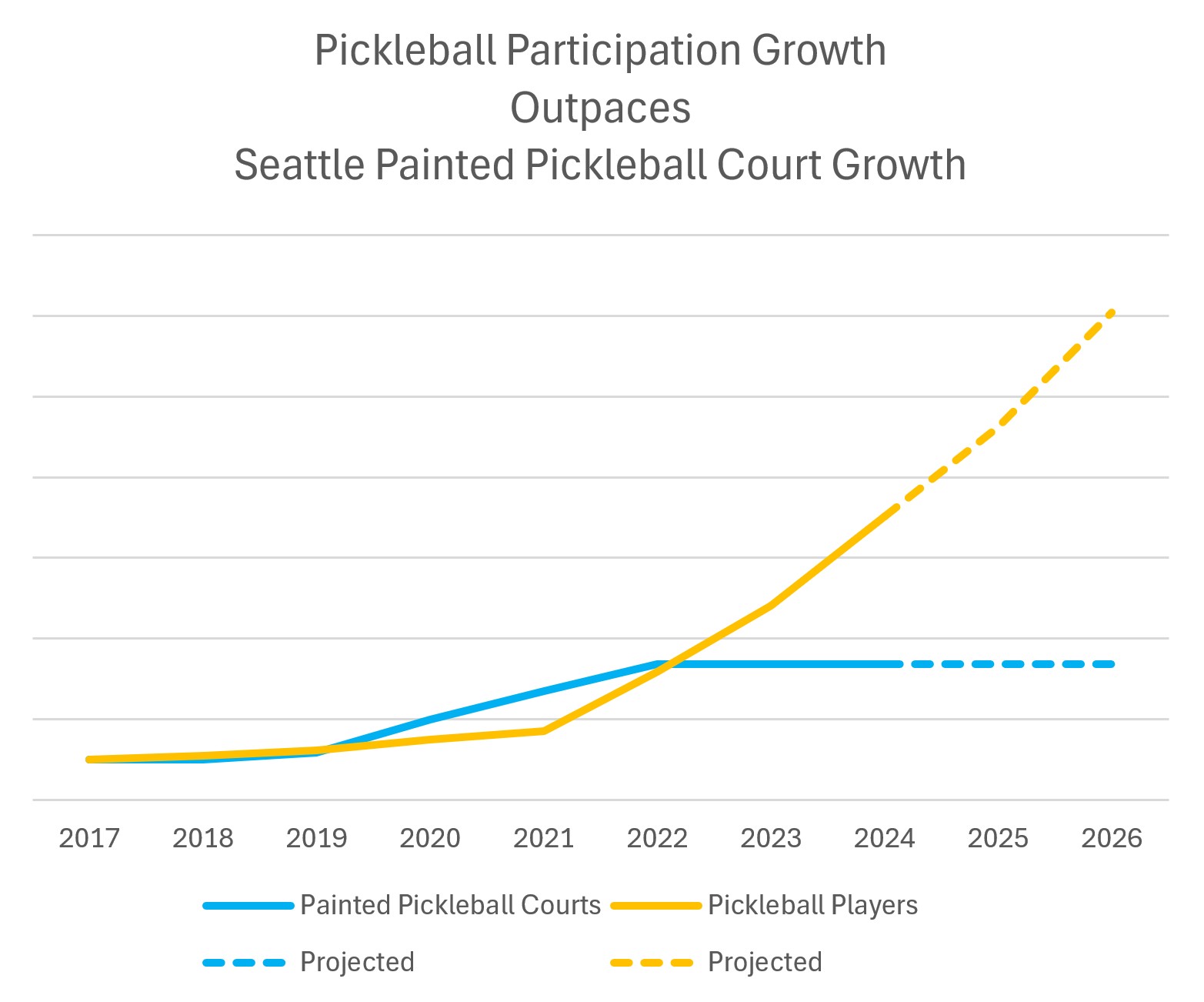
The Underlying Concern
The USTA's true concern appears to be twofold:
- Court Space - The "loss of tennis real estate" as courts are shared with or converted to pickleball
- Financial Interest - With 90% of USTA revenue coming from the US Open tennis tournament, pickleball's growth threatens their business model as "broadcasters, tennis retailers, coaches and facilities have embraced pickleball to drive engagement and to diversify revenue streams"
Inequitable Resource Allocation
Despite pickleball's explosive growth (51.8% increase in 2023 and 45.8% in 2024) and the likelihood that pickleball players now outnumber tennis players in Seattle, public court resources remain heavily skewed toward tennis. The policy decisions made by Seattle Parks, under USTA's influence, have effectively halted the creation of new public pickleball opportunities while preserving and enhancing tennis infrastructure.
The Path Forward
To ensure equitable access to public recreational facilities, parks departments nationwide must:
- Base resource allocation decisions on current and projected participation data rather than historical precedent;
- Recognize and remain independent from sports organizations with vested financial interests;
- Include representation from all affected sports communities when making policy decisions;
- Develop transparent, data-driven policies for court allocation and resource distribution.
The USTA's campaign against pickleball represents a troubling example of how an established sports organization can leverage its institutional position to hinder the growth of an emerging sport competing for the same resources. In doing so, they disregard the changing recreational preferences of the communities these public resources are meant to serve.
What You Can Do
If you play tennis
Contact the USTA and let them know how you feel about their pickleball strategy.
If you play pickleball on public courts
Contact your Parks Department. Find out if it has participated in USTA’s Park Agency Tennis Assessment and if it takes advice from the USTA. Either way, let them know what you learned here.
If you have access to the USTA Board of Director Minutes
Please send us a copy. We'd love to know what the USTA is up to these days. It is such a fascinating organization.
Remain cautiously pessimistic
The USTA might be organizing pickleball leagues and tournaments in your region. This doesn't mean it has decided to embrace pickleball or that it has stopped influencing parks departments' public recreational policy decisions.
Support your local pickleball advocacy group
Become a member of your local pickleball advocacy group. In Seattle, that would be the Seattle Metro Pickleball Association.
If your Parks Department cares about what its residents think, this is the organization it will turn to for feedback when it makes decisions affecting pickleball.
Share this web page
The more that people are aware of the USTA's strategies regarding pickleball, the less it is likely that the USTA will be successful.
Be nice to tennis players
They are future pickleball players.
Frequently Asked Questions
How did your research come about?
Seattle Parks' apparent sudden reversal of its decision to add pickleball lines to three of the six Solstice Park tennis courts in 2023 was baffling. When asked how they came to this decision, Seattle Parks was not forthcoming with an explanation.
I introduced a Public Records Request in October 2023 asking for all Seattle Parks emails and documents that contain the words "Lincoln" or "Solstice" dated or published from July 15th, 2023 to October 7th, 2023. This resulted in three batches of records delivered in December 2023, March 2024 and June 2024.
There were a few mentions of a “USTA Assessment” in some of the documents I received through this first request for public records. On a hunch, I introduced a second Public Records Request in August 2024 asking for any 2023 Seattle Parks communication that contains the words "tennis" and "assessment", or "USTA" and "assessment". This resulted in three batches of records delivered in December 2024, March 2025 and June 2025.
On the USTA web site, I found the USTA Board of Directors minutes from 2022 to 2024.
Is this all about Seattle or are other towns and cities affected too?
The United States Tennis Association (USTA) is lobbying public Parks Departments nationwide, so every town and city in the US could be affected.
We know that at least sixteen different public Parks departments are involved. They include Dallas, Columbus, Chattanooga, Moore and Philadelphia.
By April 2024, The USTA had "saved" six hundred tennis courts nationwide. This should give you an idea of the scale of their operation.
Is the United States Tennis Association still lobbying public Parks departments?
As of June 2025, we have no reason to believe that the USTA has stopped lobbying public Parks Departments. Their strategy has been successful so far. Why would they change course?
Seattle Parks (SPR) will soon release a comprehensive pickleball strategy. Will this alleviate pickleball players' concerns?
Seattle Parks is developing "a comprehensive racquet sports strategy for the short, intermediate, and long-term distribution, maintenance, and management of our outdoor racquet sports courts" and they should be commended for including court maintenance and court management in the mix.
The devil will be in the details.
It's a tennis world
As pickleball players, we have misunderstood Seattle Parks' previous pickleball studies, plans and strategies. They never were just about pickleball. They always were about how to accommodate pickleball within Seattle Parks' public tennis universe while creating the least possible amount of disruption to tennis players. As such, they were just as much, if not more, tennis plans and strategies than pickleball plans and strategies.
This time, Seattle Parks is being clear by calling this new plan its "racquet sports planning process" and its "comprehensive racquet sports strategy" rather than calling it a "pickleball study".
Given Seattle Parks' history of treating pickleball as second to tennis, and given the United States Tennis Association's clear influence on Seattle Parks as demonstrated throughout this document, pickleball players should maintain a healthy dose of skepticism but reserve their judgement until Seattle Parks reveals its plans.
No pickleball players involved yet
Seattle Parks is purposefully developing this strategy in secret "to appear agnostic to favoring either sport." They want to rely on their "collective bank of community testimonials, suggestions, complaints, and other feedback received by numerous staff throughout the years" to inform their new strategy.
If you have been reading this document, you are unlikely to believe that Seattle Parks is "agnostic to favoring either sport".
The idea of developing a solid preliminary plan in house before presenting it to everyone concerned has some merit but only if the public gets to have meaningful input on the final version of the plan.
Pickleball players have a long history of answering Seattle Parks' requests for input with very little results. For Seattle Parks' Strategic Plan for instance, Seattle Parks received hundreds of specific comments regarding pickleball which they summarized as "We need more pickleball."
Subject matter experts already involved
Meanwhile, Seattle Parks has been "vetting the strategy with subject matter experts." Pickleball players should expect a thorough articulation of the neutrality and impartiality maintained by these subject matter experts, in regard to their role in shaping public recreation policy.
Strategy without stats? That would be a swing and a miss
Any new racquet sport strategy needs to rest on actual court usage data —not just vibes, testimonials, suggestions, complaints and a mysterious rash of unsolicited feedback. It should also rely on a five- to ten-year demand forecast for both tennis and pickleball courts.
Courts delayed are courts denied
In spite of having plans to do so, Seattle Parks has not provided any new outdoor pickleball court locations in 2023 or in 2024, and probably won't in 2025 either. In fact, Seattle Parks is unlikely to make any progress in this regard until its new racquet strategy is finalized, which could take another year if community feedback is seriously taken into consideration once the initial plan is divulged.
It will be interesting to see how the new plan will attempt to make up for these drought years.
The Power of the Purse
Seattle Parks has been spending way more money on its tennis facilities than on its pickleball facilities. At what point does this become financial discrimination?
Unless Seattle Parks delivers a clear and transparent breakdown of how it allocates funding across racquet sports, pickleball players will have little reason to feel assured that all sports are being treated with financial equity.
